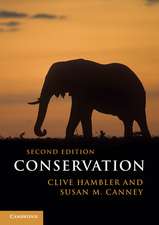On the Origins and Dynamics of Biodiversity: the Role of Chance
Autor Alain Pavéen Limba Engleză Paperback – 19 oct 2014
| Toate formatele și edițiile | Preț | Express |
|---|---|---|
| Paperback (1) | 552.45 lei 38-45 zile | |
| Springer – 19 oct 2014 | 552.45 lei 38-45 zile | |
| Hardback (1) | 641.71 lei 6-8 săpt. | |
| Springer – 30 iun 2010 | 641.71 lei 6-8 săpt. |
Preț: 552.45 lei
Preț vechi: 690.55 lei
-20% Nou
Puncte Express: 829
Preț estimativ în valută:
105.71€ • 113.04$ • 88.14£
105.71€ • 113.04$ • 88.14£
Carte tipărită la comandă
Livrare economică 14-21 aprilie
Preluare comenzi: 021 569.72.76
Specificații
ISBN-13: 9781489999047
ISBN-10: 1489999043
Pagini: 196
Ilustrații: XVIII, 178 p.
Dimensiuni: 155 x 235 x 10 mm
Greutate: 0.29 kg
Ediția:2010
Editura: Springer
Colecția Springer
Locul publicării:New York, NY, United States
ISBN-10: 1489999043
Pagini: 196
Ilustrații: XVIII, 178 p.
Dimensiuni: 155 x 235 x 10 mm
Greutate: 0.29 kg
Ediția:2010
Editura: Springer
Colecția Springer
Locul publicării:New York, NY, United States
Public țintă
ResearchCuprins
Questioning Chance.- Chance in Living Systems.- Lessons for Managing Living Systems.- The Contribution of Models and Modelling: Some Examples.- Biodiversity and Ecological Theories.- Chance and Evolution.- Evaluating Biodiversity: The Example of French Guiana.- Conclusion.
Textul de pe ultima copertă
What are the origins of chance? Although its existence has long been accepted as a fact, the theory of probability only allows us to examine the random events produced by chance without enabling us to determine what creates it – and this despite knowing that living systems (from the cell to organisms, populations, communities and ecosystems) need chance to survive. In this book on living systems, we identify two origins: one external, coming from the environment, and the other, internal, produced by biological mechanisms that are molecular as well as cellular, demographic and ecological. These internal mechanisms – veritable “biological roulettes” - are similar to the mechanical devices that bring about “physical chance”. They are at once the products and the engines of evolution and they also generate biodiversity, often in response to the vagaries of the environment. By creating biodiversity, these biological roulettes act as a kind of a life insurance that, on an evolutionary scale, ensure that life will continue after great upheaval: within the wide variety of organisms, there are some that are potentially adapted to new environmental conditions. From among those that survive, a new living world will grow and diversify. By examining biodiversity at all scales and all levels, this book seeks to evaluate the breadth of our knowledge on this topical subject; to propose an integrated look at living things; and to assess the role of chance in the dynamics of biodiversity, from populations to ecosystems and the biosphere, and more generally in evolutionary processes. Finally, it suggests that by simultaneously examining the mechanisms of diversification, maintenance and extinction, we can model the dynamics of biodiversity to better understand it and predict its variations and, thus, to foresee the practical aspects for managing living systems.
Caracteristici
This book takes stock of the biological and ecological aspects - from the gene to the ecosystem - to outline a "biological" theory of biodiversity. It shows us how these internal mechanisms are analogous to the mechanical devices that bring about “physical chance”. This book seeks to evaluate the breadth of our knowledge on biodiversity, our possible responses, and the limits of those responses to the spontaneous biological and ecological aspects that we most often overlook. Includes supplementary material: sn.pub/extras








